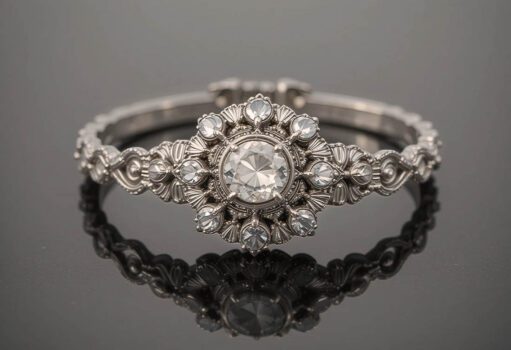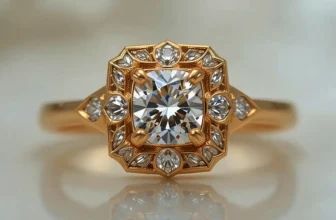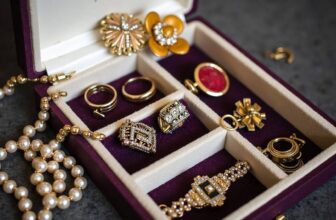Gems of the Globe: Which Countries Created the Most Iconic Art Deco Jewelry
Shopping Ads: Invest in Hidden Masterpiece: Rare Antique Oil Paintings For Sale. Limited Originals Available 💰😊 Are you looking for authentic hidden masterpiece? Explore old master antique oil paintings from the Renaissance and Baroque eras. From 16th-century portraits to 18th-century landscapes. Authenticity guaranteed, Old Master antique oil paintings for sale. Shop Now! 🎨 Renaissance And Baroque Art Old Master Portrait Paintings Landscape Antique PaintingsArt Deco jewelry, with its bold geometry, rich materials, and unmistakable glamour, defined an entire era of design between the 1920s and 1930s. From glittering Parisian ateliers to the grand jewelry houses of New York and the refined workshops of London, the Art Deco movement reshaped jewelry into a dazzling blend of art, architecture, and fashion. But which countries truly produced the most iconic Art Deco jewelry? The answer lies in the interplay of craftsmanship, culture, and innovation that emerged from France, the United States, the United Kingdom, and several others that left an indelible mark on design history.
In this in-depth guide, we’ll explore the most influential nations behind Art Deco jewelry, uncover their unique design characteristics, and understand how each contributed to one of the most luxurious artistic periods of the 20th century.
France: The Birthplace of Art Deco Elegance
France is, without a doubt, the cradle of Art Deco jewelry. The movement itself was born in Paris, taking its name from the Exposition Internationale des Arts Décoratifs et Industriels Modernes held in 1925. French designers were the first to merge fine jewelry craftsmanship with the bold, modern lines of cubism, ancient motifs, and avant-garde artistry.
The French Design Philosophy
French Art Deco jewelry emphasized balance between modernism and opulence. The aesthetic moved away from the flowing organic forms of Art Nouveau and embraced symmetry, geometry, and abstraction. Jewelers used strong contrasts , black onyx against white diamonds, emeralds with platinum, and bold color juxtapositions that captured the spirit of modernity.
Iconic French Jewelers
Some of the world’s most legendary jewelry houses perfected the Art Deco style in France:
Cartier: Perhaps the most celebrated of all, Cartier’s Art Deco designs embodied timeless luxury. From Tutankhamun-inspired Egyptian motifs to sleek platinum and diamond bracelets, Cartier combined innovation with exquisite precision. Their “Tutti Frutti” collection, mixing carved rubies, sapphires, emeralds, and onyx, became one of the era’s most iconic signatures.
Van Cleef & Arpels: Founded in 1906, Van Cleef & Arpels introduced technical brilliance with their “Mystery Set” technique during the Art Deco period , a revolutionary method that concealed gemstone settings to create seamless, luminous surfaces. The brand’s designs captured a unique balance between geometry and fluidity.
Boucheron: Another Parisian powerhouse, Boucheron embraced architectural inspiration and exotic motifs, often incorporating Egyptian, Indian, and Oriental themes. Their use of colored gemstones and unusual combinations made their Art Deco pieces stand out as both opulent and avant-garde.
Chaumet and Mauboussin: Both contributed refined geometric creations that blended elegance with innovation, using diamonds, sapphires, and onyx to express the modern aesthetic of the Jazz Age.
Cultural Influence
Paris in the 1920s was a melting pot of art, music, and design. The Jazz Age, cubism, and archaeological discoveries like King Tutankhamun’s tomb in 1922 deeply influenced French jewelers. These events inspired motifs of pyramids, scarabs, and sunbursts , hallmark elements that became synonymous with Art Deco design.
France not only produced the earliest and most artistically daring Art Deco jewelry but also set global standards for style and sophistication.
The United States: The Power and Glamour of Modernity
While France birthed Art Deco, the United States amplified it with unmatched scale and glamour. American jewelers in the 1920s and 1930s transformed Art Deco into a celebration of modern luxury, reflecting the country’s roaring economy and newfound cultural confidence.
American Interpretation of Art Deco
In the U.S., Art Deco jewelry became more streamlined, focusing on symmetry, industrial motifs, and luxury suited for the new modern woman. The aesthetic drew from architecture , particularly the rising skyscrapers of New York , and mechanical progress. Platinum became the favored metal, while diamonds and onyx were used to mirror the sleek lines of urban life.
Iconic American Jewelers
Tiffany & Co.: Tiffany embraced Art Deco early, producing elegant diamond and platinum creations that exuded both simplicity and sophistication. Their designs often mirrored the geometric precision of contemporary architecture, such as the Chrysler Building and the Empire State Building.
Harry Winston: Known as the “King of Diamonds,” Harry Winston rose to prominence in the Art Deco era by showcasing large, finely cut gemstones in balanced, architectural settings. His bold yet refined approach embodied the spirit of American luxury.
Raymond Yard: Yard’s creations epitomized American Art Deco refinement, combining classic gemstones with whimsical motifs. His jewelry often featured stylized animals, geometric brooches, and elongated diamond bracelets.
J.E. Caldwell & Co.: Based in Philadelphia, Caldwell became a leading name in Art Deco jewelry, known for their precision craftsmanship and integration of colored stones with clean, modern lines.
Hollywood’s Influence
The emergence of Hollywood during the 1920s played a crucial role in defining the glamorous side of Art Deco jewelry. Film stars like Greta Garbo, Marlene Dietrich, and Jean Harlow adorned themselves with glittering diamonds and platinum pieces, setting global trends for luxury fashion. American jewelry was not just art , it was status, aspiration, and modern beauty personified.
Architectural Echoes
Art Deco architecture in the United States influenced jewelry design directly. The sleek lines of New York skyscrapers, the chrome details of automobiles, and the geometric patterns of jazz-age interiors all found echoes in necklaces, brooches, and earrings. The result was jewelry that was not only decorative but symbolic of progress and industrial power.
The United Kingdom: Understated Glamour and Refined Craftsmanship
The United Kingdom embraced Art Deco with a uniquely British sensibility , elegant, sophisticated, and slightly restrained compared to the flamboyance of France or the boldness of America. British jewelers combined the geometry of the Art Deco movement with a sense of timeless refinement.
British Design Aesthetic
While British jewelry design drew heavily from continental trends, it emphasized symmetry, craftsmanship, and subtlety. Platinum and white gold became dominant materials, complemented by diamonds, sapphires, and calibrated gemstones arranged in precise patterns.
Leading British Jewelers
Garrard & Co.: As the Crown Jeweller, Garrard incorporated Art Deco influences into royal commissions and bespoke pieces for the British elite. Their work balanced modern geometry with classical motifs, often using intricate gemstone arrangements.
Asprey: Known for its luxurious craftsmanship, Asprey created Art Deco jewelry that reflected both innovation and regal taste. The brand’s designs often featured architectural inspiration, clean lines, and elegant gemstone combinations.
The Goldsmiths’ Company Designers: Many independent British artisans produced exceptional Art Deco pieces, often commissioned by aristocrats. Their designs showcased meticulous handcrafting and a love for symmetry and proportion.
Cultural Context
The British interpretation of Art Deco coincided with changing social dynamics , the emergence of the “flapper” generation, growing independence of women, and a fascination with modern design. Yet, British jewelry maintained a dignified restraint that made it ideal for both daywear and high-society events.
British Distinction
While Paris defined Art Deco’s artistic flair and New York embodied its modern confidence, London gave it poise. British jewelers ensured that even bold geometric designs retained a level of refinement suited to the country’s aristocratic clientele.
Italy: Where Craftsmanship Met Architectural Grandeur
Italy contributed to the Art Deco movement through a blend of classical influence and innovative artistry. Italian jewelers of the 1920s and 1930s infused their creations with Mediterranean flair , vivid colors, architectural forms, and luxurious craftsmanship.
Italian Aesthetic Characteristics
Italian Art Deco jewelry reflected the country’s rich history in design and architecture. Jewelers incorporated classical motifs like laurel wreaths, columns, and mosaics, but interpreted them through modern geometry. They favored yellow gold more than their northern counterparts and embraced bright gemstones like coral, turquoise, and lapis lazuli.
Prominent Italian Houses
Buccellati: Known for intricate metalwork and textural detailing, Buccellati’s early Art Deco creations showcased delicate engraving techniques that combined Renaissance artistry with modern design.
Bulgari: Though its international fame skyrocketed post–World War II, Bulgari’s roots in the Art Deco period were significant. Its early designs used bold color contrasts and architectural inspiration, foreshadowing the brand’s later signature style.
Cultural Influence
Italy’s Art Deco jewelry often reflected the architectural modernism that emerged under Futurism , a movement celebrating speed, power, and modernity. The result was jewelry that blended old-world opulence with cutting-edge design philosophy.
Switzerland: The Precision of Art Deco Watchmaking
Switzerland’s major contribution to Art Deco jewelry came through its world-renowned watchmaking industry. The 1920s and 1930s were golden decades for Swiss watchmakers who combined functional precision with Art Deco aesthetics.
Art Deco and Horology
The rectangular and tonneau-shaped watch cases that became popular during the Art Deco era were direct results of this movement’s influence. Clean lines, contrasting materials, and decorative engravings turned timepieces into wearable works of art.
Iconic Swiss Brands
Jaeger-LeCoultre: The Reverso, introduced in 1931, remains one of the most iconic Art Deco watches ever made. Its sleek rectangular design perfectly encapsulated the movement’s balance of form and function.
Patek Philippe: The brand’s 1920s and 1930s models emphasized symmetry and refined simplicity, often adorned with diamond-set bezels or guilloché enamel work.
Longines and Omega: Both brands created elegant Art Deco wristwatches with bold numerals, geometric cases, and sophisticated detailing.
Why Switzerland Stood Out
Switzerland turned Art Deco jewelry into wearable technology. By merging precision engineering with design elegance, Swiss artisans expanded the movement’s influence beyond necklaces and brooches into the realm of luxury timepieces.
Egypt and the East: Exotic Inspirations that Transformed Design
While not traditional jewelry-producing centers during the Art Deco period, countries such as Egypt, India, and China played a massive inspirational role in shaping the era’s aesthetics.
Egypt’s Influence
The discovery of Tutankhamun’s tomb in 1922 triggered global fascination with ancient Egyptian art. Jewelers worldwide, especially in France and Britain, began incorporating motifs like scarabs, lotus flowers, pyramids, and hieroglyphic symbols. Egyptian color palettes , turquoise, lapis lazuli, carnelian, and gold , became central to Art Deco design.
India’s Gem Legacy
India, long associated with opulent gemstones, supplied many of the vibrant rubies, emeralds, and sapphires used by European jewelers. Maharajas commissioned spectacular Art Deco pieces from Parisian houses such as Cartier and Boucheron, blending Indian extravagance with Western modernism. These cross-cultural creations remain among the most coveted jewelry ever made.
Chinese and Japanese Elements
Asian influences also contributed to Art Deco motifs. Chinese lacquer work, jade carving, and Japanese minimalism inspired jewelers to incorporate exotic materials like jadeite, coral, and enamel. These Eastern elements introduced subtle asymmetry and nature-inspired symbolism to otherwise geometric designs.
Other European Contributors: Belgium, Austria, and Germany
Smaller European nations also played important roles in advancing Art Deco jewelry craftsmanship.
Belgium: Antwerp’s diamond cutters helped define the sharp, clean gemstone cuts typical of the period.
Austria and Germany: Influenced by the Bauhaus movement, jewelers in Vienna and Berlin produced minimalist yet striking Art Deco pieces emphasizing geometry and functionality over ornamentation.
These countries contributed technically and artistically to refining Art Deco’s precision and purity of line.
The Global Legacy of Art Deco Jewelry
By the late 1930s, Art Deco had spread worldwide, influencing jewelry design from Buenos Aires to Tokyo. Its legacy endures because it perfectly captured the spirit of its age , modernity, optimism, and the fusion of art with technology.
Defining Features Across Borders
Geometry: Triangles, chevrons, circles, and sunbursts symbolized progress and symmetry.
Color Contrasts: Jewelers used onyx, coral, jade, and colored gemstones against platinum or white gold for striking visual balance.
Materials: Platinum and diamonds dominated, while enamel and lacquer introduced artistic diversity.
Themes: Egyptian, Indian, and Oriental motifs mingled with modernist architecture and abstract art.
Whether produced in Paris, New York, or London, Art Deco jewelry celebrated confidence, sophistication, and an age of transformation.
Collecting and Appreciating Art Deco Jewelry Today
Modern collectors prize authentic Art Deco jewelry for its timeless appeal and rarity. Museums, auction houses, and private collections worldwide showcase masterpieces from this golden age.
Why Collectors Value It
Historical Importance: Art Deco reflects the intersection of culture, art, and industry.
Craftsmanship: Pieces from Cartier, Van Cleef & Arpels, and Tiffany remain benchmarks of excellence.
Investment Value: Genuine Art Deco jewelry appreciates steadily due to limited supply and growing demand among luxury investors.
Where It’s Found
Major auction houses like Christie’s and Sotheby’s often feature exceptional Art Deco jewels from France and the U.S. Collectors also seek pieces from smaller British or Italian workshops, which are rarer but equally elegant.
The Countries That Defined Art Deco Jewelry
So, which countries produced the most iconic Art Deco jewelry?
The answer begins in France, where the style was born and perfected through the vision of Cartier, Van Cleef & Arpels, and Boucheron. It was then amplified by the United States, whose jewelers transformed Art Deco into a symbol of modern glamour and industrial sophistication. The United Kingdom refined it with subtle elegance, while Italy infused it with color and craftsmanship. Switzerland revolutionized the wearable art form through its timepieces, and Egypt and India provided the exotic motifs and gemstones that gave the movement its distinctive allure.
Each country added its own essence , Parisian artistry, New York confidence, London refinement, Italian passion, and Swiss precision , culminating in a movement that still defines luxury jewelry today.
Art Deco jewelry remains a testament to the harmony between innovation and beauty. A century later, its timeless geometry, cultural depth, and craftsmanship continue to captivate collectors, designers, and admirers across the globe.




